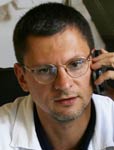 Dr Gianluca Pazzaglia
Dr Gianluca Pazzaglia
Oncologist, director of anti-aging center of Perugia, member of A.M.I.A. (Italian Association of Anti-Aging Medical Doctors), delegate of WOSAAM for Italy, received his medical degree (magna cum laude) from University of Perugia (Italy) in 1989.He followed for three years AAMS.
2007 - Hormone / Pregnenolone : A Nervous System Protector and
Memory-Enhancing Hormone for Humans too?
Neurosteroids(NS) are synthesized in the central and peripheral nervous system, particularly but not exclusively in glial cells, from cholesterol or steroidal precursors imported from peripheral sources.NS that are active on the central nervous system(Neuractive Steroids) include, mainly, Pregnenolone (PREG), Dehydroepiandrosterone (DHEA) and their sulfate esters (PREG-S and DHEA-S), as well as the reduced metabolite of progesterone, 3 alpha,5 alpha-TH PROG also called Allopregnanolone.At different places in the brain, neurosteroid concentrations vary according to environmental and behavioral circumstances, such as stress, sex recognition, or aggressiveness.These neuroactive neurosteroids alter neuronal excitability by modulating the activity of several neurotransmitter receptors such as GABA-A,NMDA, SIGMA-1 receptors, N- and L-type Ca2+ channels.These non genomic actions are mediators of short- term effects,that take place in seconds and minutes like anxiolytic or excitatory effects and Early LongTerm Potentiation.Other actions are due to the binding of NS to cytoplasmatic receptors;these when activated by this binding,translocate into the nucleus where they exert a regulatory action on genoma(genomic actions).The activation of these receptors may explain the medium and long term effects of NS such as neuronal plasticity.Therefore NS can influence behaviour,mood, stress response and cognition.There is accumulating evidence that some neurosteroids, in particular pregnenolone(PREG),have strong influences on learning and memory processes, most likely by regulating neurotransmission in the hippocampus and by neurotrophic and neuroprotective functions.PREG, the most abundant steroid in the brain, is involved in regulating the balance between excitation and inhibition in the central nervous system,and for this reason,it’s often referred as adaptogen. Several factors are responsible for the decline in memory.As we age, the functioning of the brain’s neurotransmission system deteriorates. This leads to negative changes in the release of a key neurotransmitter known as acetylcholine, ranging from a minor decline to severe alterations (Alzheimer.Dis.or A.D.).The creation of brain cells also is diminished, at least in the hippocampus ,while there is a progressive loss of neurites.Scientists have found that Preg. effectively combats all these factors.The hormone has been implicated in memory acquisition and loss in rodents.Hyppocampus has high concentration of Preg.,animals with better cognitive performances have high concentrationof Preg in the hippocampus,and administration of PREG directly into the hippocampus temporarily corrected the memory deficits of aged rats.The cholinergic activity,nmda, sigma1 receptor and pck segnal trasduction modulations, shown on physiological studies,are directly responsible for its anti-amnesic properties.Other animal studies have shown neuroprotective and neurotrophic actions too.PREG-S central infusions in aged rats dramatically increase neurogenesis and neuritis overgrowth( Mayo 2005).The researchers found a 55% increase in cell proliferation in the dentate gyrus, where newborn cells differentiate into neurons.
These actions are due to a direct effect on neurons and on microtubule-associated protein 2 (MAP2), a protein family involved in the assembly and stabilization of microtubules.These are the major structural components of the neuronal cytoskeleton,they have an essential role in the elaboration of axons and dendrites and influence the ratio between neuronal’s plasticity and stiffness( Baulieu 2006).
Preg.exerts its neurotrophic and neuroprotective effects through indirect actions too,like the modulation of inflammatory cytokines and the enhancement of the production of proteins that regutate neurites overgrowth like laminin,GAP 43,NEUROTROPHIN 3 and
CNTF.Few but very interesting studies have been conducted on humans.Preg improved memory,alertness,concentration,thinking and vision.(Rahmawati1996).Reus et al. (2001) reported greater improvement in measures of memory in healthy volunteers given Preg.compared to the placebo-treated group. In a French study(2002),was shown for the first time, a closed link between neurosteroid levels and extracellular senile plaques composed of ß-amyloid peptides (Aß) and the intracellular neurofibrillary tangles (NFT) in patients died for A.D.High levels of key proteins implicated in the formation of plaques and neurofibrillary tangles were correlated with decreased brain levels of PREGS and DHEAS, suggesting a possible neuroprotective role of these neurosteroids in AD.The data suggest that, different pathogenic factors may induce neurodegeneration in humans through the reduction of the synthesis of endogenous neuroprotective neurosteroids in nerve cells.Preg replacement therapy or therapies which stimulate neurosteroidogenesis could so preserve hippocampal plasticity and prevent the appearance of Age-Related Cognitive Disturbances.It may be important to study the effects of abnormal neurosteroid concentration/metabolism in view of the possible treatment of functional and trophic disturbances of the nervous system.